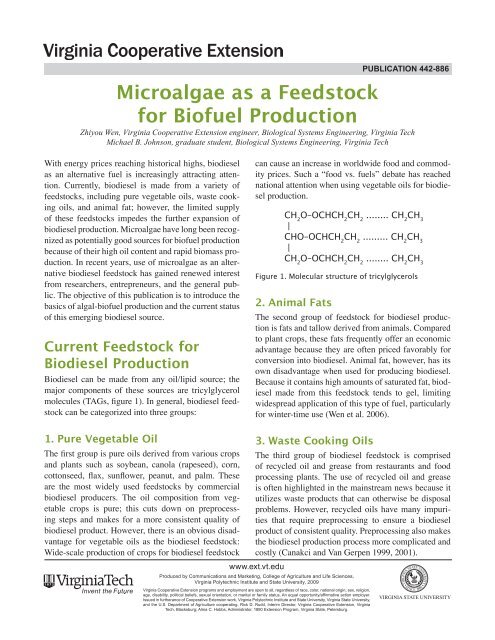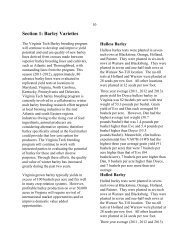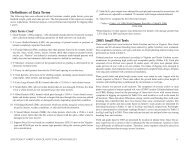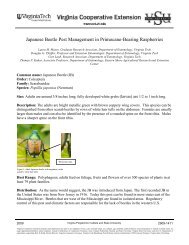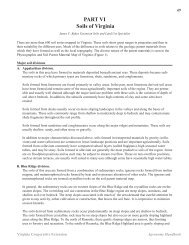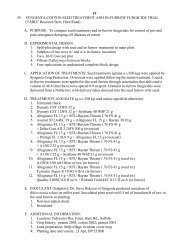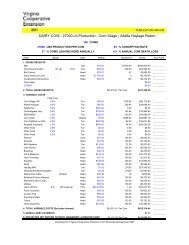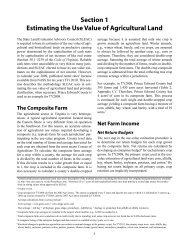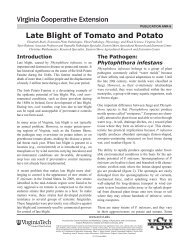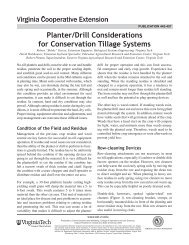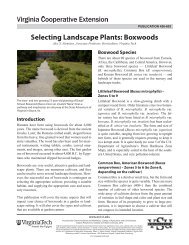Microalgae as a Feedstock for Biofuel Production - Virginia ...
Microalgae as a Feedstock for Biofuel Production - Virginia ...
Microalgae as a Feedstock for Biofuel Production - Virginia ...
You also want an ePaper? Increase the reach of your titles
YUMPU automatically turns print PDFs into web optimized ePapers that Google loves.
PUBLICATION 442-886<br />
<strong>Microalgae</strong> <strong>as</strong> a <strong>Feedstock</strong><br />
<strong>for</strong> <strong>Biofuel</strong> <strong>Production</strong><br />
Zhiyou Wen, <strong>Virginia</strong> Cooperative Extension engineer, Biological Systems Engineering, <strong>Virginia</strong> Tech<br />
Michael B. Johnson, graduate student, Biological Systems Engineering, <strong>Virginia</strong> Tech<br />
With energy prices reaching historical highs, biodiesel<br />
<strong>as</strong> an alternative fuel is incre<strong>as</strong>ingly attracting attention.<br />
Currently, biodiesel is made from a variety of<br />
feedstocks, including pure vegetable oils, w<strong>as</strong>te cooking<br />
oils, and animal fat; however, the limited supply<br />
of these feedstocks impedes the further expansion of<br />
biodiesel production. <strong>Microalgae</strong> have long been recognized<br />
<strong>as</strong> potentially good sources <strong>for</strong> biofuel production<br />
because of their high oil content and rapid biom<strong>as</strong>s production.<br />
In recent years, use of microalgae <strong>as</strong> an alternative<br />
biodiesel feedstock h<strong>as</strong> gained renewed interest<br />
from researchers, entrepreneurs, and the general public.<br />
The objective of this publication is to introduce the<br />
b<strong>as</strong>ics of algal-biofuel production and the current status<br />
of this emerging biodiesel source.<br />
Current <strong>Feedstock</strong> <strong>for</strong><br />
Biodiesel <strong>Production</strong><br />
Biodiesel can be made from any oil/lipid source; the<br />
major components of these sources are tricylglycerol<br />
molecules (TAGs, figure 1). In general, biodiesel feedstock<br />
can be categorized into three groups:<br />
can cause an incre<strong>as</strong>e in worldwide food and commodity<br />
prices. Such a “food vs. fuels” debate h<strong>as</strong> reached<br />
national attention when using vegetable oils <strong>for</strong> biodiesel<br />
production.<br />
CH 2<br />
O–OCHCH 2<br />
CH 2<br />
........ CH 2<br />
CH 3<br />
|<br />
CHO–OCHCH 2<br />
CH 2<br />
......... CH 2<br />
CH 3<br />
|<br />
CH 2<br />
O–OCHCH 2<br />
CH 2<br />
........ CH 2<br />
CH 3<br />
Figure 1. Molecular structure of tricylglycerols<br />
2. Animal Fats<br />
The second group of feedstock <strong>for</strong> biodiesel production<br />
is fats and tallow derived from animals. Compared<br />
to plant crops, these fats frequently offer an economic<br />
advantage because they are often priced favorably <strong>for</strong><br />
conversion into biodiesel. Animal fat, however, h<strong>as</strong> its<br />
own disadvantage when used <strong>for</strong> producing biodiesel.<br />
Because it contains high amounts of saturated fat, biodiesel<br />
made from this feedstock tends to gel, limiting<br />
widespread application of this type of fuel, particularly<br />
<strong>for</strong> winter-time use (Wen et al. 2006).<br />
1. Pure Vegetable Oil<br />
The first group is pure oils derived from various crops<br />
and plants such <strong>as</strong> soybean, canola (rapeseed), corn,<br />
cottonseed, flax, sunflower, peanut, and palm. These<br />
are the most widely used feedstocks by commercial<br />
biodiesel producers. The oil composition from vegetable<br />
crops is pure; this cuts down on preprocessing<br />
steps and makes <strong>for</strong> a more consistent quality of<br />
biodiesel product. However, there is an obvious disadvantage<br />
<strong>for</strong> vegetable oils <strong>as</strong> the biodiesel feedstock:<br />
Wide-scale production of crops <strong>for</strong> biodiesel feedstock<br />
3. W<strong>as</strong>te Cooking Oils<br />
The third group of biodiesel feedstock is comprised<br />
of recycled oil and gre<strong>as</strong>e from restaurants and food<br />
processing plants. The use of recycled oil and gre<strong>as</strong>e<br />
is often highlighted in the mainstream news because it<br />
utilizes w<strong>as</strong>te products that can otherwise be disposal<br />
problems. However, recycled oils have many impurities<br />
that require preprocessing to ensure a biodiesel<br />
product of consistent quality. Preprocessing also makes<br />
the biodiesel production process more complicated and<br />
costly (Canakci and Van Gerpen 1999, 2001).<br />
www.ext.vt.edu<br />
Produced by Communications and Marketing, College of Agriculture and Life Sciences,<br />
<strong>Virginia</strong> Polytechnic Institute and State University, 2009<br />
<strong>Virginia</strong> Cooperative Extension programs and employment are open to all, regardless of race, color, national origin, sex, religion,<br />
age, disability, political beliefs, sexual orientation, or marital or family status. An equal opportunity/affirmative action employer.<br />
Issued in furtherance of Cooperative Extension work, <strong>Virginia</strong> Polytechnic Institute and State University, <strong>Virginia</strong> State University,<br />
and the U.S. Department of Agriculture cooperating. Rick D. Rudd, Interim Director, <strong>Virginia</strong> Cooperative Extension, <strong>Virginia</strong><br />
Tech, Blacksburg; Alma C. Hobbs, Administrator, 1890 Extension Program, <strong>Virginia</strong> State, Petersburg.
Background of Algae<br />
Macroalgae vs. <strong>Microalgae</strong><br />
Algae are organisms that grow in aquatic environments<br />
and use light and carbon dioxide (CO 2<br />
) to create biom<strong>as</strong>s.<br />
There are two cl<strong>as</strong>sifications of algae: macroalgae<br />
and microalgae. Macroalgae are the large (me<strong>as</strong>ured<br />
in inches), multi-cellular algae often seen growing in<br />
ponds. These larger algae can grow in a variety of ways.<br />
The largest multi-cellular algae are called seaweed; an<br />
example is the giant kelp plant which can be more than<br />
100 feet long. <strong>Microalgae</strong>, on the other hand, are tiny<br />
(me<strong>as</strong>ured in micrometers), unicellular algae that normally<br />
grow in suspension within a body of water.<br />
Table 1. Oil content of microalgae<br />
Oil content<br />
Microalga<br />
(% dry weight)<br />
Botryococcus braunii 25–75<br />
Chlorella sp. 28–32<br />
Crypthecodinium cohnii 20<br />
Cylindrotheca sp. 16–37<br />
Nitzschia sp. 45–47<br />
Phaeodactylum<br />
20–30<br />
tricornutum<br />
Schizochytrium sp. 50–77<br />
Tetr<strong>as</strong>elmis suecia 15–23<br />
Source: Adapted from Chisti 2007<br />
Compared with terrestrial crops—which take a se<strong>as</strong>on<br />
to grow and only contain a maximum of about 5<br />
percent dry weight of oil—microalgae grow quickly<br />
and contain high oil content (Chisti 2007). This is why<br />
microalgae are the focus in the algae-to-biofuel arena.<br />
Table 2 lists the potential yields of oil produced by various<br />
crops and compares these values to oil yields from<br />
an open pond growing microalgae.<br />
Macroalgae & <strong>Microalgae</strong><br />
Algae <strong>as</strong> a Bioenergy Source<br />
Algae can also be used to generate energy in several<br />
ways. One of the most efficient ways is through utilization<br />
of the algal oils to produce biodiesel. Some<br />
algae can even produce hydrogen g<strong>as</strong> under specialized<br />
growth conditions. The biom<strong>as</strong>s from algae can<br />
also be burned, similar to wood, to generate heat and<br />
electricity.<br />
Algal biom<strong>as</strong>s contains three main components: carbohydrates,<br />
proteins, and lipids/natural oils. Because<br />
the bulk of the natural oil made by microalgae is in the<br />
<strong>for</strong>m of TAGs (figure 1)—which is the right kind of oil<br />
<strong>for</strong> producing biodiesel—microalgae are the exclusive<br />
focus in the algae-to-biofuel arena. <strong>Microalgae</strong> grow<br />
very quickly compared to terrestrial crops. They commonly<br />
double in size every 24 hours. During the peak<br />
growth ph<strong>as</strong>e, some microalgae can double every 3.5<br />
hours (Chisti 2007). Oil content of microalgae is usually<br />
between 20 percent and 50 percent (dry weight,<br />
table 1), while some strains can reach <strong>as</strong> high <strong>as</strong> 80 percent<br />
(Metting 1996; Spolaore et al. 2006).<br />
Table 2. Oil yields b<strong>as</strong>ed on crop type<br />
Oil yield<br />
Crop<br />
(gallons/acre)<br />
Corn 18<br />
Soybeans 48<br />
Canola 127<br />
Jatropha 202<br />
Coconut 287<br />
Oil Palm 636<br />
<strong>Microalgae</strong> 1 6283–14641<br />
Source: Adapted from Chisti 2007<br />
1<br />
Oil content ranges from 30 percent to 70 percent of<br />
dry biom<strong>as</strong>s<br />
Other Uses of Algae<br />
In addition to producing biofuel, algae can also be<br />
explored <strong>for</strong> a variety of other uses, such <strong>as</strong> fertilizer,<br />
pollution control, and human nutrition. Certain species<br />
of algae can be land-applied <strong>for</strong> use <strong>as</strong> an organic<br />
fertilizer, either in its raw or semi-decomposed <strong>for</strong>m<br />
(Thom<strong>as</strong> 2002). Algae can be grown in ponds to collect<br />
fertilizer runoff from farms; the nutrient-rich algae can<br />
then be collected and reapplied <strong>as</strong> fertilizer, potentially<br />
2
educing crop-production costs. In w<strong>as</strong>tewater-treatment<br />
facilities, microalgae can be used to reduce the<br />
amount of toxic chemicals needed to clean and purify<br />
water. In addition, algae can also be used <strong>for</strong> reducing<br />
the emissions of CO 2<br />
from power plants.<br />
Seaweeds are often used <strong>as</strong> food—<strong>for</strong> people and <strong>for</strong><br />
livestock. For example, it is often used in food preparation<br />
in Asia. Seaweed is rich in many vitamins, including<br />
A, B1, B2, B6, C, and niacin. Algae are also rich<br />
in iodine, pot<strong>as</strong>sium, iron, magnesium, and calcium<br />
(Mondragon and Mondragon 2003). Many types of<br />
algae are also rich in omega-3 fatty acids, and <strong>as</strong> such,<br />
are used <strong>as</strong> diet supplements and components of livestock<br />
feed.<br />
The Synergy of Coal and Algae<br />
One advantage of using algae biom<strong>as</strong>s <strong>for</strong> biodiesel<br />
production is the potential mitigation of CO 2<br />
emissions<br />
from power plants. Coal is, by far, the largest fossilenergy<br />
resource available in the world. About onefourth<br />
of the world’s coal reserves reside in the United<br />
States. Consumption of coal will continue to grow<br />
over the coming decades, both in the United States<br />
and the world. Through photosynthetic metabolism,<br />
microalgae absorb CO 2<br />
and rele<strong>as</strong>e oxygen. If an algae<br />
farm is built close to a power plant, CO 2<br />
produced by<br />
the power plant could be utilized <strong>as</strong> a carbon source<br />
<strong>for</strong> algal growth, and the carbon emissions would be<br />
reduced by recycling w<strong>as</strong>te CO 2<br />
from power plants into<br />
clean-burning biodiesel.<br />
Algae M<strong>as</strong>s-Cultivation<br />
Systems<br />
Most microalgae are strictly photosynthetic, i.e., they<br />
need light and carbon dioxide <strong>as</strong> energy and carbon<br />
sources. This culture mode is usually called photoautotrophic.<br />
Some algae species, however, are capable of<br />
growing in darkness and of using organic carbons (such<br />
<strong>as</strong> glucose or acetate) <strong>as</strong> energy and carbon sources.<br />
This culture mode is termed heterotrophic. Due to high<br />
capital and operational costs, heterotrophic-algal culture<br />
is hard to justify <strong>for</strong> biodiesel production. In order<br />
to minimize costs, algal-biofuel production usually<br />
must rely on photoautotrophic-algal growth using sunlight<br />
<strong>as</strong> a free source of light—even though it lowers<br />
productivity due to daily and se<strong>as</strong>onal variations in the<br />
amount of light available.<br />
Photoautotrophic microalgae require several things to<br />
grow. Because they are photosynthetic, they need a light<br />
source, carbon dioxide, water, and inorganic salts. The<br />
water temperature should be between 15°C and 30°C<br />
(approximately 60°F to 80°F) <strong>for</strong> optimal growth. The<br />
growth medium must contribute the inorganic elements<br />
that help make up the algal cell, such <strong>as</strong> nitrogen, phosphorus,<br />
iron, and sometimes silicon (Grobbelaar 2004).<br />
For large-scale production of microalgae, algal cells<br />
are continuously mixed to prevent the algal biom<strong>as</strong>s<br />
from settling (Molina Grima et al. 1999), and nutrients<br />
are provided during daylight hours when the algae are<br />
reproducing. However, up to one-quarter of algal biom<strong>as</strong>s<br />
produced during the day can be lost through respiration<br />
during the night (Chisti 2007).<br />
There are a variety of photoautotrophic-b<strong>as</strong>ed, microalgal<br />
culture systems. For example, the algae can be<br />
grown in suspension or attached on solid surface. Each<br />
system h<strong>as</strong> its own advantages and disadvantages.<br />
Currently, suspend-b<strong>as</strong>ed open ponds and enclosed<br />
photobioreactors are commonly used <strong>for</strong> algal-biofuel<br />
production. In general, an open pond is simply a series<br />
of outdoor “raceways,” while a photobioreactor is a<br />
sophisticated reactor design that can be placed indoors<br />
(greenhouse) or outdoors. The details of the two systems<br />
are described below.<br />
Open Ponds<br />
Open ponds are the oldest and simplest systems <strong>for</strong><br />
m<strong>as</strong>s cultivation of microalgae. In this system, the<br />
shallow pond is usually about one-foot deep, and algae<br />
are cultured under conditions identical to their natural<br />
environment. The pond is designed in a raceway configuration,<br />
in which a paddlewheel circulates and mixes<br />
the algal cells and nutrients (figure 2). The raceways are<br />
typically made from poured concrete, or they are simply<br />
dug into the earth and lined with a pl<strong>as</strong>tic liner to<br />
prevent the ground from soaking up the liquid. Baffles<br />
in the channel guide the flow around the bends in order<br />
to minimize space.<br />
The system is often operated in a continuous mode, i.e.,<br />
the fresh feed (containing nutrients including nitrogen<br />
phosphorus and inorganic salts) is added in front of the<br />
paddlewheel, and algal broth is harvested behind the<br />
paddlewheel after it h<strong>as</strong> circulated through the loop.<br />
Depending on the nutrients required by algal species,<br />
several sources of w<strong>as</strong>tewater—such <strong>as</strong> dairy/swine<br />
lagoon effluent and municipal w<strong>as</strong>tewater—can be<br />
used <strong>for</strong> algal culture. For some marine-type microalgae,<br />
seawater or water with high salinity can be used.<br />
3
Open ponds<br />
Harvest Feed Paddlewheel<br />
The most widely used photobioreactor is a tubular<br />
design, which h<strong>as</strong> a number of clear transparent tubes,<br />
usually aligned with the sun’s rays (figure 3). The tubes<br />
are generally less than 10 centimeters in diameter to<br />
maximize sunlight penetration. The medium broth<br />
is circulated through a pump to the tubes, where it is<br />
exposed to light <strong>for</strong> photosynthesis, and then back to<br />
a reservoir. A portion of the algae is usually harvested<br />
after it p<strong>as</strong>ses through the solar collection tubes, making<br />
continuous algal culture possible. In some photobioreactors,<br />
the tubes are coiled spirals to <strong>for</strong>m what is<br />
known <strong>as</strong> a helical-tubular photobioreactor. These systems<br />
sometimes require artificial illumination, which<br />
adds to production costs, so this technology is only<br />
used <strong>for</strong> high-value products—not biodiesel feedstock.<br />
Either a mechanical pump or an airlift pump maintain<br />
a highly turbulent flow within the reactor, which prevents<br />
the algal biom<strong>as</strong>s from settling (Chisti 2007).<br />
Baffle Flow Baffle<br />
Figure 2. Open pond system<br />
Although open ponds cost less to build and operate<br />
than enclosed photobioreactors, this culture system h<strong>as</strong><br />
its intrinsic disadvantages. Because they are open-air<br />
systems, they often experience a lot of water loss due to<br />
evaporation. Thus, open ponds do not allow microalgae<br />
to use carbon dioxide <strong>as</strong> efficiently, and biom<strong>as</strong>s production<br />
is limited (Chisti 2007). Biom<strong>as</strong>s productivity<br />
is also limited by contamination with unwanted algal<br />
species <strong>as</strong> well <strong>as</strong> organisms that feed on algae. In addition,<br />
optimal culture conditions are difficult to maintain<br />
in open ponds, and recovering the biom<strong>as</strong>s from such a<br />
dilute culture is expensive (Molina Grima et al. 1999).<br />
Enclosed Photobioreactors<br />
Enclosed photobioreactors have been employed to<br />
overcome the contamination and evaporation problems<br />
encountered in open ponds (Molina Grima et al. 1999).<br />
These systems are made of transparent materials and<br />
are generally placed outdoors <strong>for</strong> illumination by natural<br />
light. The cultivation vessels have a large surface<br />
area-to-volume ratio.<br />
Photobioreactors<br />
The photosynthesis process generates oxygen. In an<br />
open raceway system, this is not a problem <strong>as</strong> the oxygen<br />
is simply returned to the atmosphere. However, in<br />
the closed photobioreactor, the oxygen levels will build<br />
up until they inhibit and poison the algae. The culture<br />
must periodically be returned to a deg<strong>as</strong>sing zone—an<br />
area where the algal broth is bubbled with air to remove<br />
the excess oxygen.<br />
Also, the algae use carbon dioxide, which can cause carbon<br />
starvation and an incre<strong>as</strong>e in pH. There<strong>for</strong>e, carbon<br />
dioxide must be fed into the system in order to successfully<br />
cultivate the microalgae on a large scale. Photobioreactors<br />
require cooling during daylight hours, and<br />
the temperature must be regulated in night hours <strong>as</strong> well.<br />
This may be done through heat exchangers located either<br />
in the tubes themselves or in the deg<strong>as</strong>sing column.<br />
4
Deg<strong>as</strong>sing<br />
column<br />
Fresh<br />
medium<br />
Cooling<br />
water<br />
Exhaust<br />
Air<br />
Harvest<br />
Pump<br />
Solar array<br />
Figure 3. Schematic tubular photobioreactor<br />
The advantages of enclosed photobioreactors are obvious.<br />
They can overcome the problems of contamination<br />
and evaporation encountered in open ponds (Molina<br />
Grima et al. 1999). The biom<strong>as</strong>s productivity of photobioreactors<br />
can average 13 times more than that of<br />
a traditional raceway pond. Harvest of biom<strong>as</strong>s from<br />
photobioreactors is less expensive than from raceway<br />
ponds, because the typical algal biom<strong>as</strong>s is about 30<br />
times <strong>as</strong> concentrated <strong>as</strong> the biom<strong>as</strong>s found in raceways<br />
(Chisti 2007).<br />
However, enclosed photobioreactors also have some<br />
disadvantages. For example, the reactors are difficult to<br />
scale up. Moreover, light limitation cannot be entirely<br />
overcome because light penetration is inversely proportional<br />
to the cell concentration. Attachment of cells<br />
to the tubes’ walls may also prevent light penetration.<br />
Although enclosed systems can enhance biom<strong>as</strong>s concentration,<br />
the growth of microalgae is still suboptimal<br />
due to variations in temperature and light intensity.<br />
After growing in open ponds or photobioreactors, the<br />
microalgae biom<strong>as</strong>s needs to be harvested <strong>for</strong> further<br />
processing. The commonly used harvest method is<br />
through gravity settlement or centrifuge. The oil from<br />
the biom<strong>as</strong>s is extracted through solvent and further<br />
processed into biodiesel.<br />
Research and Development<br />
of Algal-<strong>Biofuel</strong> <strong>Production</strong><br />
Algal-biofuel research originated in 1979, when the<br />
U.S. Department of Energy (DOE) initiated a research<br />
program called the Aquatic Species Program (ASP).<br />
The program w<strong>as</strong> closed in 1995 due to a budget reduction.<br />
Over the 16-year project period, ASP pursued<br />
research in three major are<strong>as</strong>.<br />
The first area w<strong>as</strong> the study of the biological <strong>as</strong>pect of<br />
microalgae. It included screening and collecting a variety<br />
of algal species to access their potential <strong>for</strong> high oil production,<br />
investigating the physiology and biochemistry<br />
of the algae, and using molecular-biology and geneticengineering<br />
techniques to enhance the oil yield.<br />
The second research area w<strong>as</strong> the development of algal<br />
m<strong>as</strong>s-production systems. Several demonstration culture<br />
systems located in Cali<strong>for</strong>nia, Hawaii, and New<br />
Mexico were conducted during the project period.<br />
However, in these outdoor systems, it w<strong>as</strong> difficult<br />
to maintain the algal-oil production capacity originally<br />
obtained in the laboratory scale, and researchers<br />
encountered a severe contamination of undesirable<br />
native species. It should be noted that DOE suggested<br />
open ponds <strong>as</strong> the major system <strong>for</strong> algal-biofuel production<br />
because of their relative low cost. The cost of<br />
enclosed photobioreactors w<strong>as</strong> still prohibitive due to<br />
capital and maintenance costs, particularly <strong>for</strong> production<br />
of biofuels.<br />
The third research area w<strong>as</strong> analysis of the resource<br />
availability, including land, water, and CO 2<br />
resources.<br />
DOE concluded that there were significant amounts of<br />
land, water, and CO 2<br />
to support the algal-biofuel technology.<br />
In summary, after 16 years of research, DOE<br />
concluded that algal-biofuel production w<strong>as</strong> still too<br />
expensive to be commercialized in the near future. In<br />
its research, three factors limited commercial algal production:<br />
the difficulty of maintaining desirable species<br />
in the culture system, the low yield of algal oil, and the<br />
high cost of harvesting the algal biom<strong>as</strong>s.<br />
In recent years, with energy prices reaching historic<br />
highs, algal-biofuel production h<strong>as</strong> gained renewed<br />
interest. Both university research groups and start-up<br />
businesses are researching and developing new methods<br />
to improve algal-process efficiency, with a final<br />
goal of commercial algal-biofuel production. The<br />
research and development ef<strong>for</strong>ts can be categorized<br />
into several are<strong>as</strong>:<br />
1. Incre<strong>as</strong>ing oil content of existing strains or selecting<br />
new strains with high oil content;<br />
2. Incre<strong>as</strong>ing the growth rate of algae;<br />
3. Developing robust algal-growing systems in either<br />
open-air or enclosed environments;<br />
4. Developing co-products other than oil;<br />
5. Using algae in bioremediation; and<br />
6. Developing an efficient oil-extraction method.<br />
One way to achieve these goals is to genetically and<br />
metabolically alter algal species. The other way is to<br />
develop new growth technologies or to improve existing<br />
ones so that the same goals listed above are met.<br />
5
However, it should be noted that this new wave of interest<br />
h<strong>as</strong> yet to result in a significant breakthrough.<br />
Economics of Algal-<br />
<strong>Biofuel</strong> <strong>Production</strong><br />
The production cost of algal oil depends on many factors,<br />
such <strong>as</strong> yield of biom<strong>as</strong>s from the culture system,<br />
oil content, scale of production systems, and cost of<br />
recovering oil from algal biom<strong>as</strong>s. Currently, algal-oil<br />
production is still far more expensive than petroleumdiesel<br />
fuels. For example, Chisti (2007) estimated<br />
the production cost of algae oil from a photobioreactor<br />
with an annual production capacity of 10,000 tons<br />
per year. Assuming the oil content of the algae to be<br />
approximately 30 percent, the author determined a production<br />
cost of $2.80 per liter ($10.50 per gallon) of<br />
algal oil. This estimation did not include costs of converting<br />
algal oil to biodiesel, distribution and marketing<br />
costs <strong>for</strong> biodiesel, and taxes. At the same time, the<br />
petroleum-diesel price in <strong>Virginia</strong> w<strong>as</strong> $3.80 to $4.50<br />
per gallon.<br />
Whether algal oil can be an economic source <strong>for</strong> biofuel<br />
in the future is still highly dependent on the petroleumoil<br />
price. Chisti (2007) used the following equation to<br />
estimate the cost of algal oil where it can be a competitive<br />
substitute <strong>for</strong> petroleum diesel:<br />
C algal oil<br />
= 25.9 x 10 -3 C petroleum<br />
where: C algal<br />
oil is the price of<br />
microalgal oil in dollars per<br />
gallon and<br />
C petroleum<br />
is the price of crude oil<br />
in dollars per barrel<br />
This equation <strong>as</strong>sumes that algal oil h<strong>as</strong> roughly 80<br />
percent of the caloric energy value of crude petroleum.<br />
For example, with petroleum priced at $100 per barrel,<br />
algal oil should cost no more than $2.59 per gallon in<br />
order to be competitive with petroleum diesel.<br />
Algal <strong>Biofuel</strong> in<br />
the Near Future<br />
Algal biofuel is an ideal biofuel candidate which eventually<br />
could replace petroleum-b<strong>as</strong>ed fuel due to several<br />
advantages, such <strong>as</strong> high oil content, high production,<br />
less land, etc. Currently, algal-biofuel production is<br />
still too expensive to be commercialized. Due to the<br />
static cost <strong>as</strong>sociated with oil extraction and biodiesel<br />
processing and the variability of algal-biom<strong>as</strong>s production,<br />
future cost-saving ef<strong>for</strong>ts <strong>for</strong> algal-oil production<br />
should focus on the production method of the oilrich<br />
algae itself. This needs to be approached through<br />
enhancing algal biology (in terms of biom<strong>as</strong>s yield and<br />
oil content) and culture-system engineering. In addition,<br />
using all <strong>as</strong>pects of the microalgae <strong>for</strong> producing<br />
value-added products besides algal fuel—such <strong>as</strong> in an<br />
integrated biorefinery—is an appealing way to lower<br />
the cost of algal-biofuel production. Indeed, microalgae<br />
contain a large percentage of oil, with the remaining<br />
parts consisting of large quantities of proteins, carbohydrates,<br />
and other nutrients (Spolaore et al. 2006). This<br />
makes the residue after oil extraction attractive <strong>for</strong> use<br />
<strong>as</strong> animal feed or in other value-added products.<br />
References<br />
Canakci, M., and J. Van Gerpen. 1999. Biodiesel production<br />
via acid catalysis. Transactions of the ASAE 42:<br />
1203–10.<br />
Canakci, M., and J. Van Gerpen. 2001. Biodiesel production<br />
from oils and fats with high free fatty acids.<br />
Transactions of the ASAE 44: 1429–36.<br />
Chisti, Y. 2007. Biodiesel from microalgae. Biotechnology<br />
Advances 25: 294–306.<br />
Grobbelaar. J. U. 2004. Algal nutrition. In Handbook of<br />
Microalgal Culture: Biotechnology and Applied Phycology.<br />
ed. A. Richmond, 97–115. Ames, Iowa: Blackwell<br />
Publishing.<br />
Metting, F. B. 1996. Biodiversity and application of<br />
microalgae. Journal of Industrial Microbiology 17:<br />
477–89.<br />
Molina Grima, E., F. Acien Fernandez, F. Garcia<br />
Camacho, and Y. Chisti. 1999. Photobioreactors: Light<br />
regime, m<strong>as</strong>s transfer, and scale up. Journal of Biotechnology<br />
70: 231–47.<br />
Mondragon, Jennifer and Jeff Mondragon. 2003. Seaweeds<br />
of the Pacific Co<strong>as</strong>t. Monterey, Calif.: Sea Challengers.<br />
ISBN 0 930118 29 4.<br />
Spolaore, P., C. Joannis-C<strong>as</strong>san, E. Duran, and A. Isambert.<br />
2006. Commercial application of microalgae.<br />
Journal of Bioscience and Bioengineering 101: 87–96.<br />
6
Thom<strong>as</strong>, D. N. 2002. Seaweeds. W<strong>as</strong>hington, D.C.:<br />
Smithsonian Books; London: Natural History Museum.<br />
ISBN 0 565 09175 1.<br />
Wen, Z., R. Grisso, J. Arogo, and D. Vaughan. 2006.<br />
Biodiesel Fuel, <strong>Virginia</strong> Cooperative Extension<br />
publication 442-880. http://pubs.ext.vt.edu/442-880/<br />
(accessed November 4, 2008).<br />
Acknowledgements<br />
The authors express their appreciation <strong>for</strong> the review<br />
and comments made by Bobby Clark, <strong>Virginia</strong> Cooperative<br />
Extension agent, Shenandoah County Office;<br />
Bobby Grisso, Extension engineer, biological systems<br />
engineering, <strong>Virginia</strong> Tech; John Ignosh, area specialist,<br />
biological systems engineering, <strong>Virginia</strong> Tech; and<br />
Wenqiao (Wayne) Yuan, <strong>as</strong>sistant professor, Department<br />
of Biological and Agricultural Engineering, Kans<strong>as</strong><br />
State University.<br />
7


